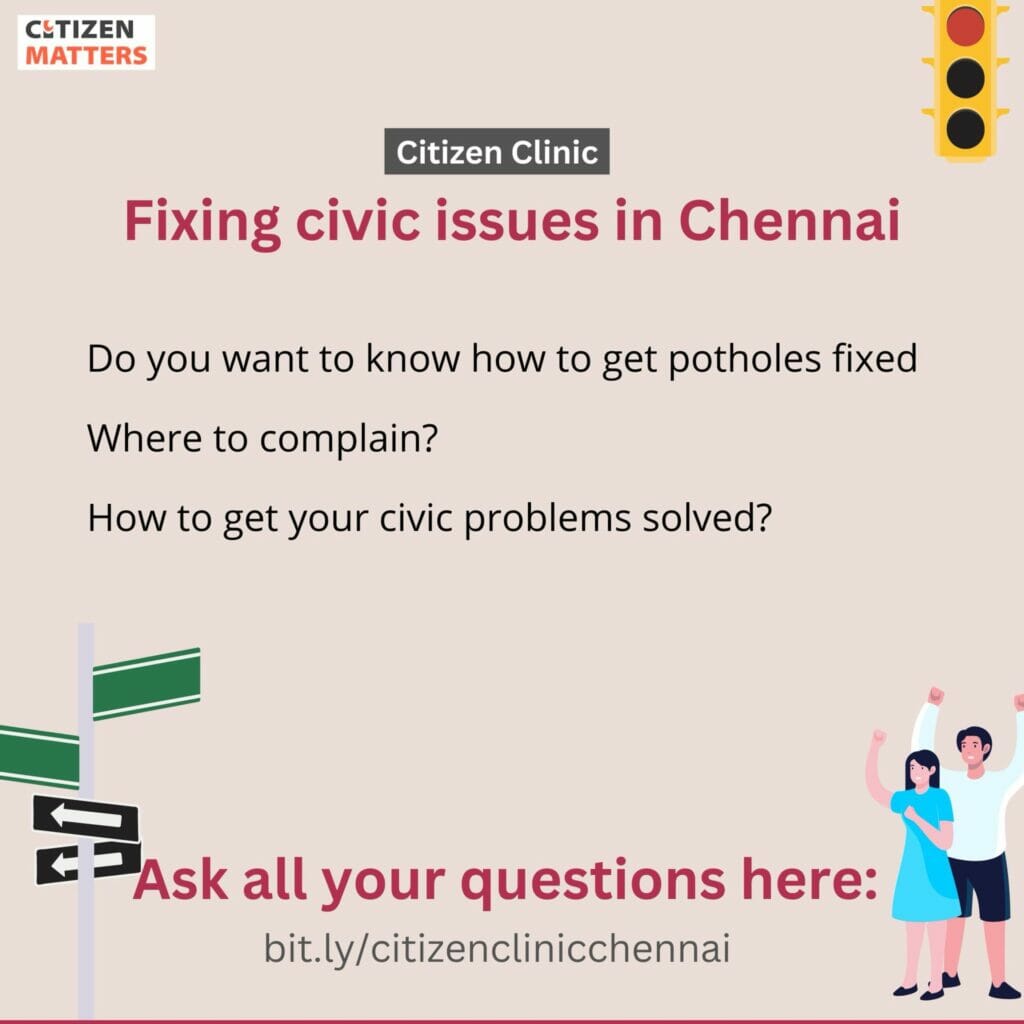Citizen Matters Chennai organised a Citizen Clinic on Fixing Civic Issues in Chennai with a panel of civic activists providing guidance and sharing their experience in engaging with civic authorities. The panel considered questions on issues such as waste management, water supply, parking and drainage and offered suggestions on the steps to be taken to solve these issues.
The panel comprised Raghukumar Choodamani, a resident of Perambur and the Founder of Community Welfare Brigade, a civic engagement forum; Sridhar Venkataraman, a resident of Mylapore and a social activist and Vasanthi Kannan, a civic activist and Secretary of the Kodambakkam Residents and Civic Welfare Association.
The panel shared a range of recommendations such as the use of Namma Chennai app and the 1913 helpline to raise complaints, constant vigilance on part of residents in monitoring civic works taking place in their neighbourhood and the need to maintain a dialogue with civic authorities working in the area to address any issues.
Read more: How citizen protests can help fix civic issues in Chennai
Know your civic officials to solve civic issues in Chennai
Maintaining a list of contacts of relevant civic officials and raising complaints with them at the local level is one way to solve civic issues. Raghukumar shared his strategy of sharing the phone numbers of various civic officials with members of the Community Welfare Brigade on Whatsapp. Residents can raise issues with regard to improper waste management or issues with drainage or flooding at the local level with the Assistant Engineers (AE) and Executive Engineers (EE). If persistent complaints with the AE or EE do not yield results then the panel suggested escalating the issue to the Zonal Officers and the Regional Deputy Commissioners.
Sridhar and Vasanthi shared their experience in escalating issues, with matters that remained unaddressed at the local level being solved with the involvement of higher officials at the Greater Chennai Corporation. Visiting officials in person at their offices with a petition or detailed outline of complaints tends to yield faster and better results. Another avenue to raise complaints would be the open house meetings organised by various departments where officials are present. The express purpose of these meetings is grievance redressal.
Issues with raising complaints on apps and helplines
Sridhar related positive experiences with using the Namma Chennai app to raise complaints on civic issues. However, the experience with using the web portal to lodge complaints has been less than satisfactory. The panel also pointed out issues with disabling the option to reopen a complaint on the app. In the absence of an avenue to reopen complaints, civic officials have been found to close complaints without completely resolving them.
The inability to track the status of a complaint and the steps taken to resolve it, either through the app or the 1913 helpline is another issue that the panel raised as an impediment to effectively addressing civic issues.
Raghukumar also shared an alarming incident where little was done to protect his identity as a complainant. As a result of lack of such safeguards, he was subject to harassment for raising complaints against encroachments in his locality.
Read more: Residents step up to monitor Mandaveli SWD work
Leveraging social media to raise civic issues in Chennai
The panel also recommended residents use all means possible to highlight civic issues. In addition to petitions and online complaints, social media can be used to amplify civic issues and gather support or fellow residents. Campaigns by residents on social media will also attract the attention of newspapers and serve as a way to increase their reach. Fellow residents can also be made aware of the civic issues in the area through the use of Facebook, Twitter, Instagram and WhatsApp. Official handles of politicians and elected representatives can be tagged to alert them of the problems that require their attention.
Raghukumar shared an example of the broken granite slabs which were used to top up footpaths in Thiruvanmiyur. The broken pathway posed a danger to those who used the path. Raghukumar shot photos and videos of the broken slabs and shared them on social media, tagging the relevant civic authorities. The issue was taken up by the civic officials who fixed the broken pathway.
Residents wrote in with questions on a range of civic issues, for which the panel shared recommendations on the steps to be taken for specific complaints and also provided inputs on how broader issues can be dealt with effectively.
Follow the complete discussion here:

Every MLA in a particular constituency should have the list of issues raised in different forum and provide regular updates in dashboard format (in social media or other platform easily accessible to public) with number of issues raised vs number of issues actually resolved to make the authorities more accountable and people participate in development process. Many tickets closed are to mention that they have understood our concern but not necessarily resolved. For example in one instant there were dangerous narrow steep major roads not even two vehicles could pass. When the issue was raised the the ticket was closed after stating nothing can be done due to some reason or they would look into it.